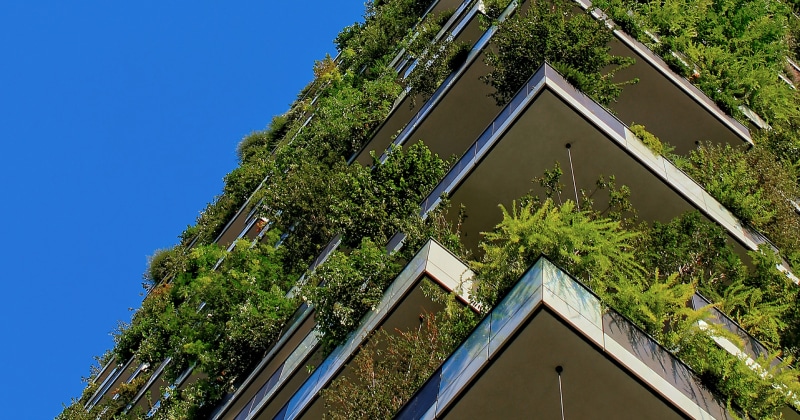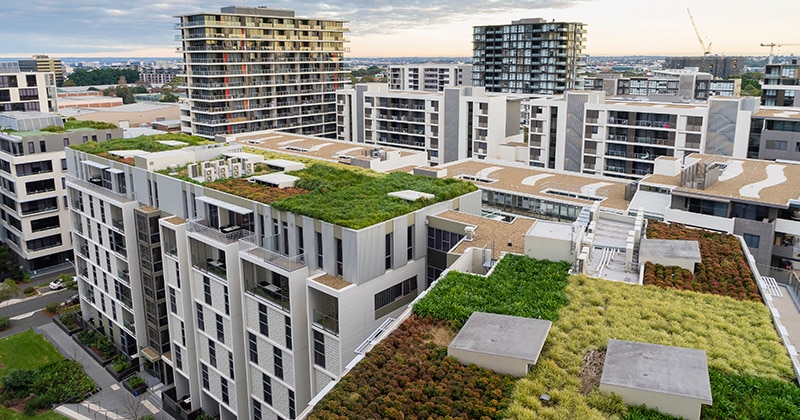What Are the Benefits of a Green Roof?
A green roof is different from a traditional roof in several ways. Green roofs help wildlife, improve air quality, boost insulation, and provide a host of other benefits. Here’s what you need to know about this emerging trend.

Managing Editor
Business leaders, homeowners, and city planners are all looking for ways to make buildings more sustainable. As a result, green roofs are getting an increasing amount of attention.
A green roof is different from a traditional roof in several ways.
Aesthetically, green roofs are striking. And then there are the environmental effects to consider. Green roofs help wildlife, improve air quality, boost insulation, and provide a host of other benefits.
In this article, we’ll start by explaining what a green roof is. We’ll discover how a green roof is different from a traditional roof. Finally, we’ll walk you through the benefits of a green roof.
And there are plenty.
What Is a Green Roof?
A green roof is a roof that includes a layer of soil and vegetation on top of a layer of waterproofing. A green roof is typically installed on a flat or only slightly slanted roof.
There are two types of green roofs.
Extensive Green Roofs
An extensive green roof has shallow roots and low-growing vegetation. Extensive green roofs typically include a layer of soil that’s just 3-4 inches deep.
Because so little soil is needed, extensive green roofs don’t usually require a great deal of additional structural support. Most are also designed to be very low maintenance.
Intensive Green Roofs
By contrast, an intensive green roof can support taller plants and even trees. That’s because intensive green roofs feature deeper soil and irrigation systems.
As a result, intensive green roofs can be incorporated into surrounding landscaping. They provide more insulation, too. But they require considerably more structural support.

Green Roofs vs. Traditional Roofs
A traditional roof is straightforward. It’s a solid structure that covers and protects the building it covers.
Most residential buildings use asphalt shingles for the roofing. Asphalt shingles are a popular option because they’re inexpensive and relatively easy to install.
But asphalt shingles lack the environmental and aesthetic benefits of a green roof. Plus, asphalt shingles don’t provide the layer of insulation a green roof provides.
Asphalt shingles are a solid roofing option. They’re the go-to choice for most homeowners and home builders for good reason.
But the advantages of a green roof are compelling.
The History of Green Roofs
All of this begs a simple question. Why aren’t green roofs more popular?
In truth, green roofs aren’t a new concept. They’ve been around for centuries. Ancient Greeks and Romans used green roofs to insulate their homes. The added vegetation kept them cool in the summer months.
In more recent history, green roofs have been spotted across Europe and in the U.S. and Canada.
Green Roof Trends
The popularity of green roofs is on the rise in urban areas. What’s more, green roofs are becoming increasingly popular in the United States.
The lift in popularity likely has its roots in several key factors:
- Environmental awareness is a hot topic. The benefits of a green roof make it a great environmentally-friendly option.
- The cost of green roofs has decreased as technology and materials have improved.
- Aesthetically, it’s hard to compete with the beauty of a well-designed green roof.
- The benefits of green roofs are becoming more well-known and understood.
As the popularity of green roofs continues to grow, we can expect to see more of them, particularly in urban areas.
What Are the Benefits of a Green Roof?
A green roof is great for energy-efficient construction, but has many other benefits, both for the building it covers and the environment.
Here are some of the most significant benefits of a green roof.
Improved Stormwater Management
Green roofs can absorb up to 75% of rainfall. This reduces the amount of runoff and helps to prevent flooding.
They can be a particularly effective way to manage stormwater in urban areas where concrete and asphalt surfaces prevent water from seeping into the ground.
“Research at Penn State has shown that green roofs provide considerable reduction in the volume of stormwater …”
– PennState Extension
Increased Insulation
Green roofs can help regulate indoor temperatures. They do this by providing an extra layer of insulation.
Extra insulation can reduce the need for heating and cooling. As any homeowner can tell you, that leads to significant savings.
Plus, a well-insulated home is more comfortable to live in.
Improved Air Quality
Green roofs improve air quality by absorbing pollutants and releasing oxygen.
They can also help to cool the air by providing shade and evaporating water.
Extended Roof Life
Green roofs can extend the life of a roof by two to three times.
The vegetation and soil help to protect the roof from UV rays, extreme temperatures, and physical damage.

Reduced Urban Heat Island Effect
The urban heat island effect refers to the increased temperature in urban areas. This is caused in part by surfaces, like concrete and asphalt, that tend to absorb and trap heat.
Green roofs can help reduce the urban heat island effect.
Habitat for Wildlife
Green roofs provide a habitat for birds, insects, and small animals.
They also help connect fragments of habitat that would otherwise be isolated by urban development.
Aesthetic Improvements
Green roofs improve the appearance of a building and make it more inviting.
They also provide a convenient place for people to relax and enjoy the outdoors.
A Green Roof Is a Solid Option
Green roofs are beneficial for the environment. Plus, they save money and energy in the long run. And don’t forget the fact that they are often stunning, improving the overall look of a building.
When choosing a green roof, it’s important to consider the climate, the slope of the roof, and the weight of the vegetation. You should also consider the maintenance requirements and the roof’s expected lifespan.
A green roof is a great way to make your home or business more sustainable and reduce your impact on the environment.
Ashley’s professional experience includes content creation of all kinds, from articles and infographics to websites and whitepapers. When she’s not working, she enjoys dark coffee, dad jokes, and fiction—mostly horror and urban fantasy.


